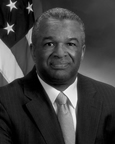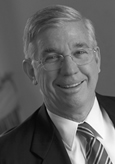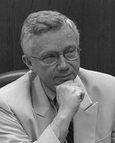New Partners for Smart Growth
Lifetime Achievement Award
2010
 Ron Sims, Deputy Secretary, U.S. Department of Housing and Urban Development; former King County Executive (PDF)
Ron Sims, Deputy Secretary, U.S. Department of Housing and Urban Development; former King County Executive (PDF)
Ron Sims was one of the first local government leaders to understand the importance of “growing smart” by integrating health, land use and transportation planning to create walkable, transit-oriented and sustainable communities that provide healthier lifestyle choices for all residents. He was also one of the first U.S. leaders to apply equity and social justice factors in government policy and decision-making.
Sims served as King County Executive from 1997 until 2009, when he was appointed Deputy Secretary of the U.S. Department of Housing and Development by President Obama.
As Deputy Secretary, he is responsible for the new Sustainable Communities Initiative that, for the first time, acknowledges the impact of the built environment on energy consumption and global warming. The initiative fosters sustainable development and lowers transportation costs by integrating transportation and housing planning to maximize choices for residents and businesses. The initiative uses HUD’s prominent role in the housing industry to catalyze the retrofit of existing homes and buildings and promote environmentally sustainable home construction.
To get the job done, I knew we would have to bring together everyone — environmentalists, developers, community leaders — to create a strategy to preserve the livability of our region. It didn’t take long to realize we shared a common interest in clean air, water and healthy communities.– Ron Sims, HUD Deputy Secretary
A Spokane, Washington native and lay minister who worked with youths on the streets of downtown Seattle, Sims co-chaired the Committee to End Homelessness in King County. His commitment to expanding housing for the homeless and working poor made him well-suited to HUD. Under his leadership, King County was the first county in the nation to earn the Robert L. Woodson Jr. Affordable Communities Award from HUD.
As County Executive, Sims became renowned for his collaborative approach to problem-solving. This approach contributed to numerous achievements, including national recognition for his focus on climate change. Under his leadership, King County Metro Transit and Sound Transit became one of the largest, greenest transit systems in the nation, with the country’s largest fleet of articulated hybrid buses. In 2006, Metro Transit became the first county and transit agency to join the Chicago Climate Exchange and account for its greenhouse gas emissions under a voluntary cap-and-trade system. Soon after, Sims helped start Climate Communities, a coalition of cities and counties across the country advocating for federal action on climate change.
A leader in launching the effort to save Puget Sound, Sims expanded the state’s largest wastewater system, establishing state-of-the-art treatment facilities. He created the first countywide flood protection plan to avoid Katrina-like catastrophes. He worked with builders, environmental groups and cities to protect diminishing agricultural and timber areas while focusing growth in the cities – 96% of King County’s residential growth is now in the urban area. Further, he conserved more than 135,000 acres of open space.
2009
 Parris N. Glendening, former Governor of Maryland; President, Smart Growth Leadership Institute, Smart Growth America (PDF)
Parris N. Glendening, former Governor of Maryland; President, Smart Growth Leadership Institute, Smart Growth America (PDF)
Parris Glendening’s name is so synonymous with the words “smart growth” that many people believe he must have coined the phase. While he may not have been the first person to put those two words together, he has done as much as anyone in the country to popularize not only the phrase but many of the concepts behind smart growth.
As Maryland’s 59th governor, Glendening thrust the issue of smart growth into the national consciousness with the 1997 enactment of his Smart Growth and Neighborhood Conservation program, the first statewide, incentive-based growth management initiative in the nation. Throughout the remainder of his two terms in office and continuing into his current role as president of the Smart Growth Leadership Institute (a project of Smart Growth America), Glendening has left a permanent imprint on the land use and environmental policies of his home state and his nation.
Glendening’s public career began at the municipal level, moved to the county level, and concluded at the gubernatorial level. During that long career in elected office, he strongly advocated for smarter development balanced with land conservation and environmental protection. Under his leadership, Maryland revised its building rehabilitation code, created novel new revitalization programs, invested in transit and access to transit stations, promoted walking, supported the revitalization of historic theatres and other architecturally significant buildings, and required that state offices be located in downtown areas.
His administration inventoried and mapped all of the ecologically significant lands in Maryland and created — and funded — a variety of land preservation programs. During his eight years in office, an array of state and local land preservation programs were employed together to save more than 285,000 acres or nearly 4 percent of the land mass of Maryland. That nearly matched the 325,000 acres that had been protected by all of the governors together who preceded him from 1970 to the present.
While Governor, Glendening was elected by his peers to serve as chairman of the National Governor’s Association, a position he used to put “quality growth” on the agenda of all the nation’s governors. He has continued to work directly with governors as head of the Governors’ Institute on Community Design, a joint project of the U.S. EPA and the National Endowment for the Arts.
We have the ability to make things better. The answer largely depends on how well governments manage growth, how well we use existing infrastructure, how well we conserve and reinvigorate our existing neighborhoods, and how often we stretch our imaginations and use our creativity…– Parris Glendening
Glendening’s interest in growth issues started when, as a college student in Florida, he sensed that something was wrong as he watched sprawl steadily advance toward the Everglades. He went on to receive bachelor’s, master’s and doctorate degrees from Florida State University, all in political science. Following graduation, he taught political science for 27 years at the University of Maryland. He was elected to statewide office after serving on the Hyattsville city council and three terms as county executive of Prince George’s County, a jurisdiction of 800,000 outside Washington, DC.
He has received both the American Society of Landscape Architects’ Olmsted Award and Harvard University’s Innovations in American Government Award for his dedication to preserving open space, containing sprawl, and revitalizing Maryland’s communities. He also was twice named “Public Official of the Year” by Governing Magazine, the first time as county executive and the second as governor due to the impact of his nationally recognized smart growth program.
2008
 Richard J. Jackson, MD, MPH: A national leader in improving the health of the people (PDF)
Richard J. Jackson, MD, MPH: A national leader in improving the health of the people (PDF)
Dr. Richard J. Jackson has dedicated his professional life to protecting the health of the public and training future generations of public health leaders.
Jackson received his M.D. from the University of California, San Francisco and M.P.H. from UC Berkeley. He began his diverse, multi-faceted career as a public health officer in the San Francisco Bay Area. He served nine years as Director of the National Center for Environmental Health at the U.S. Centers of Disease Control and Prevention (CDC). His most recent position brought him back to UC Berkeley, where he was a professor of environmental health. Jackson has just accepted a position at the University of Michigan to lead the Graham Environmental Sustainability Institute and will take over the job in late February.
It was while he was working at the CDC that Jackson began to focus on the connection between land-use planning and health. He co-authored the influential book, “Urban Sprawl and Public Health: Designing, Planning, and Building for Healthy Communities,” which exhaustively describes the negative health effects of sprawl.
As an inspiring, articulate, visionary speaker, Jackson rapidly came to the forefront of the smart growth movement and has tirelessly and selflessly served as a keynote speaker at workshops and conferences held throughout the U.S. and England.
In early 2004, Jackson left the CDC to accept an appointment by Governor Arnold Schwarzenegger as California’s State Public Health Officer. During his tenure there, he traveled to most of the state’s 58 counties to meet with local public health officials and speak at meetings, conferences and workshops about the negative effects of poor land-use planning on health. His impact is clearly visible as many planners and public health officials throughout the state are now working together.
We can create environments that can be much smarter in terms of protecting the planet, protecting human well-being and, in the long run, protecting the economy and prosperity.– Dr. Richard J. Jackson
Jackson’s accomplishments have extended far beyond the smart growth movement. His work in California has strengthened farmworker health protection, food safety and child health.
The California Birth Defects Monitoring Program was established through his efforts.
At the Centers of Disease Control and Prevention, he worked for the addition of folic acid to food to prevent birth defects, established the national asthma epidemiology and control programs, and oversaw the childhood lead poisoning prevention programs.
Jackson instituted the current federal effort to biomonitor chemical levels in the U.S. population, and in the wake of the Chernobyl disaster, was the U.S. lead under several government efforts around health and environment in Russia, including radiation threats. In the late 1990s, he was the CDC leader in establishing the U.S. National Pharmaceutical Stockpile to prepare for terrorism and other disasters – a plan that was activated following the World Trade Center attack.
Dr. Jackson has served on many medical and health boards. Since 2005, he has served on the board of directors of the national American Institute of Architects. For the past three years, he has also served on the board of directors of the Children’s Environmental Health Network.
Jackson’s positive impact on the world as we know it today is both measurable and inspirational. The smart growth movement would not be where it is today without him. We will be eternally grateful to him for his tireless leadership.
2007
 Dan Burden: Passionate Innovator, Ambassador for Walkable, Livable Communities (PDF)
Dan Burden: Passionate Innovator, Ambassador for Walkable, Livable Communities (PDF)
Dan Burden hardly needs an introduction with a smart growth audience. For the past 11 years, the man with the broad mustache, infectious laugh, mischievous twinkle in his eye and energetic step has been roaming North America — about 350 days of the year — preaching the gospel of walkable, livable, healthy communities.
His signature brightly colored shirts, photographer’s vest (with multiple cameras and other gadgets attached) and Nike shoes have been spotted in towns and cities across the continent, north and south from Fairbanks, Alaska, to Key West, Florida, and east and west from Chula Vista, California, to Montpelier, Vermont. At last count, Dan had conducted walkability audits, community workshops and design charrettes in more than 2,100 communities across the U.S. and Canada.
In 2001, Time magazine cited Dan as one of six international “civic innovators.” He is considered a national expert on traffic calming, street design, walkability and bicycling. However, in his own modest way, Dan often points out that a large part of what he does is to use his skills as a former National Geographic photographer to observe and to help local residents learn how to see what works and what doesn’t work in their own communities.
Cars are happiest when there are no other cars around. People are happiest when there are other people around.– Dan Burden
Dan received his B.S. in recreation planning from the University of Montana, and has more than 30 years experience in urban design and transportation planning. Since 2005, he has served as Senior Urban Designer with the firm of Glatting Jackson Kercher Anglin Lopez Rinehart, Inc., as well as the founder and executive director of Walkable Communities, Inc., a nonprofit corporation that helps develop walkable communities, since 1996.
Highlights of a Distinguished Career
- Florida’s first state bicycle and pedestrian coordinator (1980-96)
- Founder and executive director or president of three national, non-profits, including the Adventure Cycling Association, America’s largest bicycle touring organization (formerly named Bikecentennial, 1973-77) and Bicycle Federation of America, Inc. (1977-80)
- Founder and original publisher of “Bicycle Forum” magazine (1977)
- Expedition leader of “National Geographic”-sponsored Hemistour – an Alaska-to-Argentina bicycling expedition (1971-73)
- Distinguished lecturer at Transportation Research Board, 2001, Washington, DC.
- Course developer and trainer for the National Highway Institute, Federal Highway Administration / National Highway Traffic Safety Administration topics in pedestrian/bicycle safety, planning, engineering and related topics
- U.S. representative for United Nations’ six-member world team to the People’s Republic of China, providing technical support in bicycle safety program development (1994)
- Prolific author of many articles, manuals and books, including the State of Florida’s “Bicycle Facilities Planning and Design Manual” (1981) and “Pedestrian Facilities Planning and Design Manual” (1996); the bicycle section of ITE’s “Traffic Safety Toolbox;” and the Local Government Commission’s “Street Design Guidelines for Healthy Neighborhoods” (1998), “Streets and Sidewalks, People and Cars: A Citizens Guide to Traffic Calming” (1999) and “Emergency Response, Traffic Calming and Traditional Neighborhood Streets” (2000)
